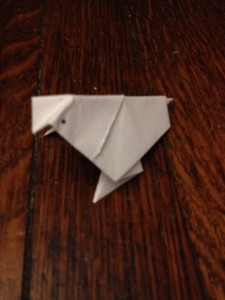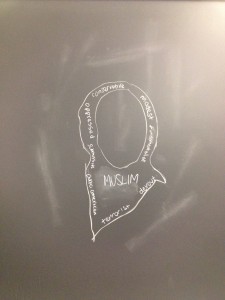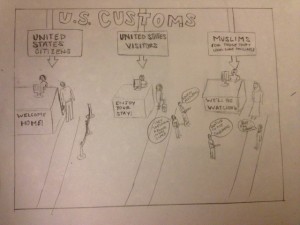Prologue: A Personal Academic Exploration
Link to intro essay (PDF)
At the start of the term, during our first section, Ceyhun asked each of us why we were taking this class. There were a wide variety of answers, and I myself had a few answers to this question myself. Yes, it counts as an AI credit. Yes, it counts towards my degree in the Comparative Study of Religion. But most importantly, as a Muslim myself, it allowed me to explore a side of my faith that I have not had the chance to explore in great detail ever before. I grew up Muslim and had gone to Sunday school for years. This exposed me deeply to the legal, ritualistic and practical side of Islam, all of which is beautiful. However, as Professor Asani notes in his text, it is really only one side of Islam (Asani, Chapter 1). Then, as a child growing up in post-9/11 America, I also engaged with another side of Islam—specifically, political Islam. I was in a position that left me uniquely aware of my Muslimness, as one of very few people of color and even fewer Muslims at my school. The news and media showed me a version of Islam that I didn’t recognize and couldn’t believe, one that was contrary to everything I believed and everything I had learned about Islam, the Quran, the Sunnah, and Islamic History.
As I was exposed to the historical, traditionally religious, and political sides of Islam, I had yet to realize that there was another dimension of Islam that I hadn’t even begun engaging with. On a trip to Turkey after I had already graduated college, I found myself in Konya, the resting place of the great Mawlana Jalal al-Din Rumi. From here I began learning about the rich literary and poetic history of Islam, and when I came to college, I wanted to continue that study. I mention in one of my blog posts that I also took another class with Professor Asani, specifically a class on Sufism. This course again exposed me to the literary wonders of Islam, but it also introduced me to the world of Islamic music and dance and celebration that I never knew existed and whose exploration was only possible through the cultural studies approach that Professor Asani’s teaching embodies. And that is what brought me to this course. I titled this prologue “A Personal Academic Exploration” because while this course is technically part of my college academic curriculum, it also holds so much personal value in its ability to broaden my understanding of Islam and the ways in which Islam can be engaged. Through the process of creating this blog, engaging with my own interpretations of the art, music, literature, and scholarly work that we studied, I was able to not only see, but experience first hand the diversity an beauty of all that is contained in the Islamic faith and tradition. My blog thus presents my experiences with Islam in its many diverse forms through these artistic practices and can hopefully enlighten others in the way this class enlightened me.
Throughout my artwork, there are many themes that are embodied. One of these themes is the omnipresence of Islam and God and our engagement with Him through our various senses. Outside of personal engagement with faith, God can be found everywhere, in architectural designs, in nature, in quiet moments of personal happiness. As an avid photographer who is particularly engaged with landscape photography, I wanted to put this idea to the test with my first post, in which I “found” Allah written in nature—in smoke, in rocks and in leaves. This is undoubtedly a very unique way of engaging with Islam, but it was also very meaningful to me. Further, in the Islamic tradition, it is said that God is beautiful and loves beauty. By capturing some of the beauty that God has placed around the world, I understood a new way of engaging with the Islamic God. Renard, in his Seven Doors to Islam, touches on this idea, exploring the many ways we can experience God outside of the traditional rituals of faith. While the visual aspects are one of those ways, another is the auditory. The auditory tradition in Islam has deep roots. The Quran itself was first transmitted through oral recitation and even now, communal recitations of the Quran are very popular. However, the aesthetic that comes with recitation is a little known art that truly is an art, and an incredibly beautiful one at that. We watched a movie documentary on Quran reciters and one on architectural design and the incorporation of calligraphy. In both of those, what stood out was the theme of the aesthetic engagement with Islam—seeing and hearing it in the world around you, rather than just in the confines of traditional religious practice. My second piece in my series aims to engage both of these things together, by combining the auditory and visual experiences of Islam in a way that admires the traditional in non-traditional ways. It is a synthesis of finding God in the world around you and then experiencing that discovery spiritually through sound and sight. I especially found the auditory aspect so elucidating, so I furthered that exploration in my blog post from Week 10, in which I listened to the audio of the poem Conference of the Birds while simultaneously working on my art.
A second theme, seen in my piece related to Conference of the Birds and in my post relating to the Ta’ziyeh is that of the role integration—specifically integrating Islamic concepts, practices, and works of art into new mediums that are not traditionally associated with Islam. In my case, I combined the Ta’ziyeh, which is a traditional re-enactment of the death of Hussain with the art of fashion design. And in my later post, I combined the characters from Attar’s text with the traditionally Japanese art of Origami. By melding these art forms with Islamic artistic expressions of Taziyeh and Attar’s poetry, I was able to exemplify how Islam, through a cultural approach, can be spread beyond what one might expect. Further, I was able to really work with my hands when creating the origami, a process that allowed me to reflect on the difficulties of self purification that are thematic in Attar’s Conference of the Birds. By using the cultural studies model in my own artwork, I was able to push the bounds of Islamic artistry by incorporating Islamic concepts into traditionally secular art forms.
Finally, in a set of works that are personally my favorite and that truly embody the amalgamation of my lived experience as a Muslim and my work in this course, I engaged with the themes surrounding Islam and Muslims in the Western world—particularly profiling of Muslims and stereotypes of the Hijab. In an age where Donald Trump, a man who has openly expressed his distaste for Muslims and has asked to ban them from this country, has essentially secured the GOP Presidential bid, the realities of Muslim experiences in America are particularly important topics of conversation. While also deeply emotional, these issues have been brought to the forefront of political and social discussion after many years of silence. As someone who is not very confrontational, I found that doing these art pieces allowed me to express my frustrations with these experiences without feeling exposed. It was a truly cathartic experience—a key characteristic of art in every form. In particular, I focused on two issues, which were also very clearly exemplified in literary works such as The Reluctant Fundamentalist and Persepolis. These works highlighted the experiences of discrimination Muslims face in the West when for example, as seen in my comic drawing, they are given extra attention at the airport. I myself have noticed that when I am traveling with my family members, many of whom wear headscarves and some of whom have beards, we are always stopped and asked for extra screenings. And especially, my mom and sisters who wear a scarf are almost always patted down alongside their full body scan. In a tragic example of bigotry and discrimination, unfortunately this kind of profiling has extended beyond just Muslims to those who have any similar resemblances to Muslims. Often times, this leaves Sikhs, Middle Eastern individuals, and South Asians, who are not necessarily Muslim stuck facing discrimination that is aimed at Muslims. At the root of this behavior are stereotypes and misconceptions about Muslims, which is seen most potently in the politicization of the Hijab. The Muslim headpiece has become a symbol of oppression, anti-feminism, radical Islam, and so many other incredibly hurtful things over the past years. Muslims have reported facing serious harassment because of this, and I myself am hesitant about wearing a scarf in public because of fear of public backlash. An unfortunate reality of living as a Muslim in the Western world, I hoped to highlight some of these stereotypes and the damage they can do through my artwork. Thus, I was able to not only purge my own emotions as a Muslim who has experienced these issues, but also express them in a way that is hopefully relatable and can convey what I learned in the texts I have read to a larger audience.
At the core of my artwork is a combination of three themes. These are centralized on using the cultural studies approach to embrace Islam and its diversity through experience, engagement, and expression. It has provided me the opportunity to be reflective on the effects the art I have studied has had on me and my own understandings of Islam as well as how my own art can contribute to broadening understandings of Islam held by others. Through this process, I have seen how using a cultural studies approach, and engaging with the literary and artistic elements of a faith tradition can expand that tradition and make it accessible in ways that it previously was not. I would like to end by thanking all of those who have made this experience so uniquely available to me, especially, Professor Asani, John, and Ceyhun.





